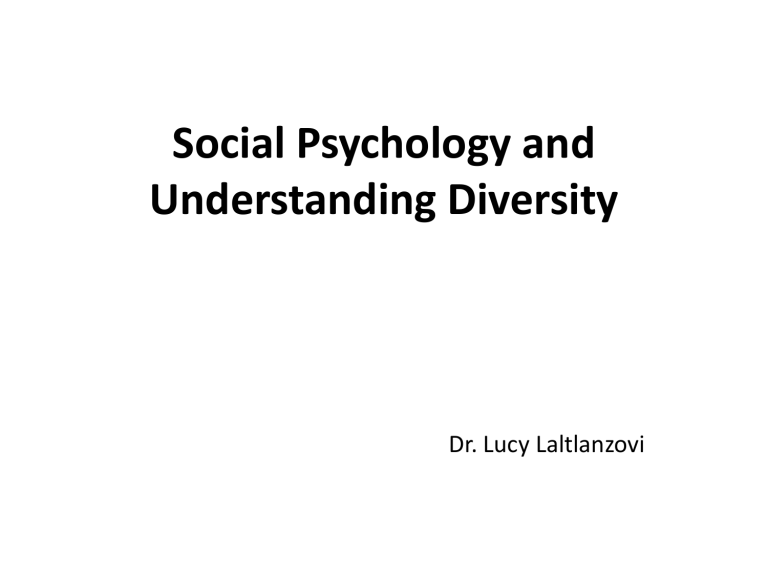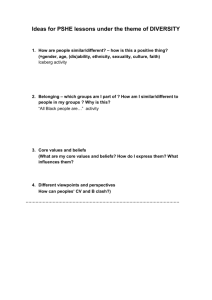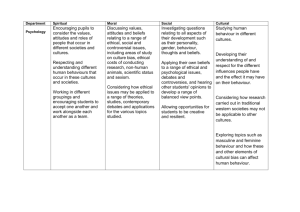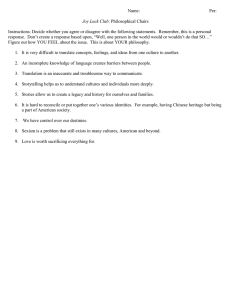
Social Psychology and Understanding Diversity Dr. Lucy Laltlanzovi Diversity • If we look around, we certainly understand that we exist in a ‘diverse’ social world. • People around us belong to various nationalities, ethnic identities, cultural backgrounds, socioeconomic status, religious beliefs etc. • Diversity refers to differences in how people look, how they think, and how they behave. Diversity • Diversity is a wide array of people that come from different backgrounds, lifestyles, social experiences, races, and religions. the coexistence of various perspectives (political, religious), backgrounds (racial/ethnic, sexual orientation, nationality, gender). • We still continue to live alongside this diversity as individuals with a strong sense of belonging to our particular community or group. • The world is diverse; people have diverse values, diverse behaviours, and diverse customs, and they wear diverse clothing. • The meaning of the term diversity within psychology extends beyond simply acknowledging that differences exist to understanding that diversity can arise from many different sources. • Some of the more common sources include ethnicity, nationality, religion, sex, sexual orientation, physical ability, and social class. • Differences across these categories reflect the layers that make us who we are, and it is these differences that coexist in each of us. • Some aspects of diversity are the result of learned ways of doing things. • For example, in some cultures individuals learn that the best way to eat is with a knife and fork, in other cultures chopsticks are favoured, and in still other cultures fingers are the utensils of choice. • Other aspects of diversity are the result of birth; for example, sex and ethnicity. • Three major domains of demographic diversity: – Ethnicity/shared cultural characteristics – Sex, and – Social class. Some other common types of diversity are: • Religion: People belong to various religious backgrounds and faith around us. • Age: In any given place, people of different ages and more importantly, generations co-exist together. Sex/ Gender: Gender has numerous aspects to it which makes it diverse. Agender (not having a gender), gender conformity, gender dysphoria, sexual orientation are just a few ways of looking at the concept. • Disability: The diversity in the experiences of people having disabilities (both physical and psychological) requires the world around to adjust and help in adaptation by making it an inclusive environment. • Besides these, there exist some intangible characteristics like education, personality, life experiences etc. that contribute towards human diversity. • The presence of diversity often leads to experiences of bias and discrimination. • These biases lead to the way perceptions are formed of each other. • Two important ideas follow from the fact that we, as individuals, are perpetually embedded in diversity. • First, because individuals are literally part of the social contexts in which they behave, those situations cannot be understood independently of the people in them. • Example: Have you ever been amazed that you perceived a situation, such as a job interview, much differently than a friend? Perhaps you approached the interview with optimism and confidence, regarding it a potentially positive step in your career goals. Your friend, however, may have viewed the same scenario as threatening and bemoaning how it would never work out. • This illustrates how social situations are, in vital part, constructed and maintained by people. • We project our own attitudes, feelings, expectations, and fears onto the situations we encounter. • Applied to our social contexts, this principle says that the differentness we perceive between ourselves and other people, or among other people, may be inaccurate. • There are times when we project too much social difference onto our contexts and the people in them. • At other times, however, we underestimate the diversity around us. So, the diversity of our lives is partly a function of us—our individual ways of thinking and emotional needs. • Second, because people live and behave in diverse social contexts, then individuals cannot be understood independently of the situations in which they act and interact. • Are you sometimes a different person, or do you show a different side of yourself, as your social setting changes? • For example, do you display different table manners when eating with your friends at the café than during a holiday meal with the family? • Do you think of yourself differently in those situations? • If so, then you realize how we are, in vital part, social beings. • Our behaviour and identity are constructed and maintained by the situations in which we act and live. Likewise, our thoughts and actions flex with the situational norms we encounter. • If we are interested in explaining who we are and why we behave the way we do, we must look to the social context for insight. • The diversity of our social contexts is laden with informative clues to help us demystify our own behaviour and confront our attitudes and beliefs. • • • • • A social psychological study of diversity must: Examine how diversity shapes our own identities and behaviour. Examine how we shape the diversity of our social worlds. Confront a wide range of diversity dimensions, not just those that are associated with historical disadvantage. Recognize the social injustice that attends many dimensions of diversity, and use our scientific knowledge to respond to injustice. Recognize not just social differences, but also the diversity within, and similarities between, groups of people. The Social Psychology of Diversity: A Conceptual Framework I. Diversity Is Socially Constructed a) The Individual is a Social Perceiver: As individuals living in a social world, we confront and process volumes of social information each day. From others’ skin colour to facial characteristics, from their clothing preferences to political attitudes, we sift through, organize, and make sense of countless pieces of social information. • Although we can be very fast and efficient in the way we process these data, psychological researchers have demonstrated that we commonly make mistakes and exhibit inaccuracies in our thinking about other people and our social world. • These tendencies and errors have consequences for our conclusions and judgments about our social world and the people who comprise it. • We tend to rely on information that is most available in our memory banks to help us make judgments about other people, and this information leads us to make mistakes in judging the diversity of our social environments. b) The Individual is a Social Actor: Not only are we social perceivers, we also act within our social contexts in ways that have implications for diversity. • We typically bring into our interactions with other people a set of beliefs and expectations about them. These expectations can function in two ways: guiding the way we act toward other people and influencing the way others react to us. • Our behaviour often sends signals to other people about their differentness and how they are expected to act, leading them to live up to (or, more commonly, down to) those expectations. • In this way, our behaviour toward others actually alters the extent of difference in our social environment. • • • • Our actions toward socially different others are also driven by our feelings about ourselves. These social identities are value-laden; we are proud of being, for example, Jewish, Latino, or female. Because we are emotionally invested in our social categories and memberships, we want them to compare favourably with other social groups. The desire to have our social group look good compared to others invariably guides us to behave in ways that create or enhance differences between us. In short, the diversity we perceive in our schools or communities may result in part from our needs to feel good about our own social groups. II. Diversity Is a Social Influence • To study how the individual and the social context are interdependent, we must recognize that our behaviour is influenced by a variety of social forces, one of which is our differentness from others. Therefore, we not only perceive social difference in our environments, many of us experience diversity too. • We are aware that we are different from other people in many ways, such as in our skin colour, family background, and religious beliefs. This experience is psychologically important because being different from others influences the way we think and feel about ourselves and interact with other people. a) Influence on Identity: Social psychologists have learned that our identities—whom we regard ourselves as— incorporate the impressions and beliefs others hold regarding us. • The experience of diversity acknowledges that we live among people who, themselves, are constructors of their social world. • In other words, other people categorize you based on dimensions of social difference (just as you tend to do to them). • • • Other people may not know you personally, but as a member of some (often visibly apparent) social group about which they have prior knowledge, you are known to them to some degree. The ‘you’ that is known to other people, and based largely on your social group affiliation, may differ sharply from how you view yourself. The discrepancy between our identities and the way other people identify us has profound implications for our psychological well-being and social adjustment. • One’s social identities, beliefs and assumptions that other people associate with those identities have important implications for one’s psychological identity and wellbeing. • In sum, a psychological appreciation of diversity must include an understanding of the experience of being different from others. b) Influence on Behavior: The experience of diversity extends beyond how we identify ourselves and includes how we behave. • Just as our actions toward others that are guided by category-based expectations have implications for the perception of diversity, others’ behaviour toward us follows their beliefs and expectations about us and influences how we experience a diverse world. • Others’ beliefs and expectations about the traits and behaviours of the members of a social group comprise a role—a script for conducting oneself in the ongoing drama of life. • However, social roles are a double-edged sword. • On one hand they are comfortable contexts in which to live, because playing the expected role brings the approval of others. • On the other hand, social roles are limiting; they constrain what a member of a social group should be or do. • For example, there is still a strong collective belief in this society that women are best suited for roles that involve nurturing, supportive, and helpful behaviour. • Not surprisingly, women greatly outnumber men in such occupations as elementary school teacher, nurse, and secretary. • Adopting this female role in one’s behaviour is associated with opportunities in those vocational areas, as well as a cultural stamp of approval at playing the woman role appropriately, but also place women at an economic disadvantage. • You can see, then, how our behaviour is not ours alone, but is shaped by cultural forces that stem directly from social differences. • • • • Societies: Cultural Diversity Culture can be described as the shared values that guides to live. The term was first used by Taylor in 1871. Taylor defined culture as “that complex whole which includes knowledge, belief, art, morals, laws, customs and any other capabilities and habits acquired by man as a member of society.” Broadly speaking, the term culture refers to factors, such as race and ethnicity, which exert differential influence over the lives of individuals in different groups. • More specifically, culture may be defined as a dynamic system of rules, explicit and implicit, established by groups in order to ensure their survival, involving attitudes, values, beliefs, norms, and behaviours shared by a group, but harboured differently by each specific unit within the group, communicated across generations, relatively stable with the potential to change across time. (Matsumoto & Juang, 2004, p. 10) • Cultural diversity is increasingly a part of all of our lives. • Urban, suburban, and even rural areas are becoming more culturally diverse, and with increased globalization this diversification will continue both in the interactions in our daily lives (e.g., schools, workplaces), and in the broader social structure (e.g., social functions, media). • Culture has a pervasive influence on the lives of individuals within it. • Its reach extends from the more obvious factors, such as values and beliefs, to the less obvious ones, such as nonverbal behaviour and communication styles. • There are many aspects to culture, and these aspects can result in many differences across groups of people. • For example, people from different countries may sometimes be identified by the type of clothing they wear. • Similarly, an individual’s religion can sometimes be identified by how the person dresses, such as with some members of the Amish and Islamic communities. • Behavioral differences can also result from culture. • Although shaking hands when meeting someone is the norm now in many parts of the world, the traditional greeting in Japan is a bow while placing one’s hands together in front of the face, whereas nodding is the appropriate greeting in India. • However, not all of culture’s effects on behaviour are as immediately visible as greetings. • Culture is socially transmitted through enculturation and socialisation. • Thus, most of the behaviours that can be perceived in a context and culture is a prominent context. • As individuals belonging to various cultures come together due to various reasons like migration for work and education, due to globalisation and so on, the result is cultural diversity. • There are various dimensions of culture as stated by Hofstede, that leads to individual differences in the values and preferences that are learned. These are discussed as follows: 1. Individualism and collectivism: An idiocentric (denoting interest in or focus on one's self rather than on other objects or people) individual, that is an individual with individualism orientation will follow his/her own goals without taking in to consideration the views of his/ her family members. • On the other hand, an allocentric ( having one's interest and attention centred on other persons) individual, that is an individual with collectivistic orientation will behave in manner that is seen as beneficial for the group and for that he/she may even give on his/her personal goals. • America and Canada can be seen as allocentric examples of individualistic societies. Whereas, India can be seen as an example of collectivistic allocentric society (Kwantes et al. 2012). 2. Power distance: This is yet another dimension of culture and can be explained as the extent of acceptance of inequality (that is based on status in society, power, physical characteristics and so on) by the individuals in society. • Thus, there can be cultures that have high power density (for example, Malaysia and Philippines) and cultures that have low power density (Germany and New Zealand). 3. Masculinity and femininity: This dimension mainly focuses on work related goals. • Cultures that have high masculinity focus in encouragement of recognition at work place, competitions and advancement at workplace. Whereas, cultures that have high femininity focus on relationships and provide significance to harmony. • Examples of masculinity culture are Japan and Italy and examples of femininity culture are Sweden and the Netherlands (Kwantes et al. 2012). • Gender differences may exist in values endorsed in masculinity cultures, whereas such a gender difference is not found amongst femininity cultures. 4. Uncertainty avoidance: This dimension mainly has to do with coping process when uncertainties are faced. • High levels of uncertainties can lead to generation of stress and anxiety amongst the individuals. And this is relevant in this context because every society will teach its individuals ways of coping with uncertainties. • Societies with low uncertainty avoidance believe that uncertainties cannot be avoided and they need to be firm. • Example of such a society is Singapore. • Societies with high uncertainty experience threat, when faced with uncertainty, example of such a society is Germany. 5. Long or short term orientation: In cultures with long orientation, the future rewards are valued and thus patience, harmony and persistence are given more importance; for example, Taiwan and South Korea. • Whereas, in cultures with short term orientation, the focus is on immediate rewards and quick gratification; for example, Canada. Demographics: Personal Diversity • People differ on core characteristics that are key determinants of life experiences. These characteristics and experiences affect how we see ourselves and create different pieces of identity that are like links on a chain; one never exists without the others. • A man from an upper-class background cannot necessarily differentiate the parts of his experience that are related to being upper-class from the parts that are related to being male. • Similarly, our own experiences are intertwined with our own characteristics. • People respond to us because of a combination of these factors and rarely to any one factor alone. • Our life experiences are affected by these largely socially constructed factors stemming from both visible aspects (e.g., race, gender, social class) and in/non-visible aspects (e.g., sexual identity, religion) (Bierema, 2010; Mannix & Neale, 2005; Wilton, MossRacusin, Good, & Sanchez, 2015). • A closer look at gender, race, and social class, each of which continues to influence one’s experiences and opportunities are discussed as follows: 1. Gender: Although many people use the terms sex and gender to mean the same thing, there is actually a difference between them. • The term sex refers to the biological distinction of being male or female, whereas the term gender refers to the social or learned characteristics that are associated with being male or female. • Boys are moulded to become what society considers to be masculine (e.g., independent, assertive), whereas girls are moulded to become what society considers to be feminine (e.g., caring, dependable). • Behaviors that match these expectations are often associated with rewards (Robinson & HowardHamilton, 2000) while behaviours that violate these expectations are often associated with costs (Good & Sanchez, 2010). • Men, for example, were more frequently associated with descriptors such as aggressive, capable, and rational, whereas, women were more frequently associated with descriptors such as affectionate, dependent, and emotional. • Although things have changed from the time when women were thought to be too intellectually inferior or too weak and frail to participate in many aspects of society, a belief in the fundamental difference between the sexes is still evident in modern cultures (Benokraitis & Feagin, 1995). • The focus on differences and the ignoring of similarities have been the basis of much of the feminist critiques of research on gender (Hyde, 1991). • One of the responses to gender diversity or the differences between the sexes (whether real or perceived) is sexism, that is, differential and often detrimental treatment of a person based on that person’s sex. • The term sexism likely brings to mind thoughts of negative or demeaning attitudes toward women. 2. Ethnic Background: Another domain of diversity is ethnic (nation/tradition) diversity. Like gender, ethnicity is often used as a way in which to group people together. • Unfortunately, a common response to ethnic diversity is racism. • Racism can be defined as bias against an individual or a group of individuals based on the individual’s or group members’ race/ethnicity. • In most (but not all) situations, it is no longer considered acceptable to make directly racist comments, and so racism tends to reveal itself in indirect ways. • In other cases, perceived social norms against racism inhibit the likelihood that someone will admit to racist attitudes or beliefs. • As such, these forms of prejudice (preconception) may be more subtle and indirect. • An example of a form of modern racism is aversive racism (Gaertner & Dovidio, 1986). • Despite holding racist beliefs, aversive racists believe that they are not prejudiced against people from races other than their own. They do not acknowledge their racial biases because this perspective is inconsistent with their view of themselves as egalitarian/democratic. • Therefore, although racism is present, the racist attitudes are not conscious (Nelson, 2002). • Similarly, symbolic racism (Sears, 1988) also does not manifest itself in obvious ways. • In instances of this type of racism, a negative attitude is associated with something other than the target. • For example, an individual may insist that he or she is not racist and has “nothing against Blacks.” However, the individual may also say that there is a problem with affirmative action, something that he or she believes give an unfair advantage to Blacks over Whites in hiring practices. • Ambivalent racism (Hass, Katz, Rizzo, Bailey, & Eisenstadt, 1991), like ambivalent sexism, contends that people can simultaneously hold two attitudes that are inconsistent with each other. • With this type of racism, people are not overtly prejudiced and do recognize the unfair treatment of minorities and racial disparities, but at the same time they believe that the system is based on meritocracy, that is, the principle that hard work will pays off—the “American Dream” (Hilton & von Hipple, 1996). • As a result of holding this attitude, these individuals are more willing to accept different outcomes for people of different races/ethnicities in the belief that everyone has had the same opportunities, but that individuals from some groups have not taken full advantage of the opportunities available to them. • 3. Social Class: Issues relating to social class constitute another example of how the ideal of equal opportunity, and the belief that individual effort always pays off pervades many Western societies, allowing people to avoid acknowledging structural and systemic inequalities. • Those who are economically disadvantaged have historically been described as belonging to a culture of poverty (Mincy, 2000). • This culture has been assumed to be the result of values and attitudes held by impoverished individuals and is viewed as part of what separates those in the lower socioeconomic strata from those in other strata. • Research suggests that social class is indeed a determinant of how we “size people up.” • For example, Kirby (1999) found that class bias was involved in people’s impressions of new neighbours. She found that people were more likely to object to their new neighbours if they believed that the neighbours were receiving public assistance, and that this bias was one that participants expressed candidly. • Younge (2003) suggested that the notion of equal opportunity is often used to excuse the huge disparity in economic realities. • The concepts of the deserving poor and the undeserving poor are rooted in people’s perceptions of those who comprise the lowest socioeconomic classes (Mincy, 2000). • The undeserving poor are those whose economic conditions are assumed to be through no fault of their own. • For example, individuals who are handicapped, are mentally ill, have some other life circumstances that have clearly affected their ability to earn a living are often given sympathy, and we are less likely to hold their economic circumstances against them. • However, most individuals are assumed to have equal opportunity and equal access to earning a living. • Those who fall into the deserving poor category are those whom others think should have taken advantage of the supposed opportunities, but have not done so due to their own lack of initiative. • This artificial and frequently erroneous pattern of assumptions allow others, especially those who are more privileged, to justify the existence of social class inequalities. • Unfortunately, these assumptions about equal opportunity are so deep-seated that they are difficult to overcome, even for the people who are the most disadvantaged by societal inequalities. • Gender, ethnicity, and social class constitute majority of the many ways in which we are demographically diverse. • Each of these differences does not operate in isolation; we are complex individuals with many different aspects to our identities. • Different identities in race and culture shape individuals' worldviews, and in turn, their psychology. It's also beneficial for individuals within the field of psychology to be representative of the population as a whole.




